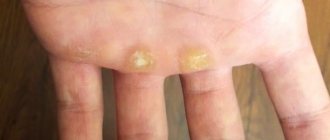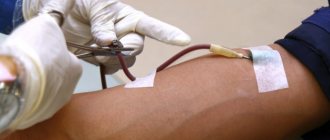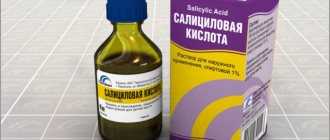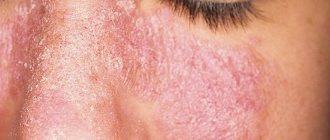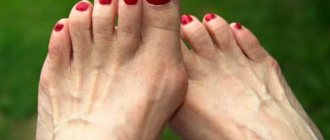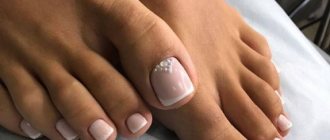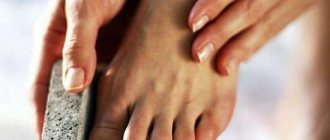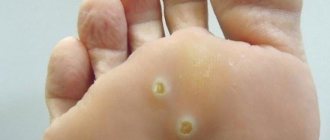Blood calluses are familiar to many people who spend quite a lot of time on their feet. It differs from the usual one in its appearance and contents - bright red contents inside the callus. The red color of the callus comes from the blood that enters it from nearby vessels. The callus differs not only in appearance, but also in the treatment characteristics.
Photo 1. Bloody calluses most often appear on the feet. The treatment methods for these calluses are different from the usual ones. Source: Flickr (Richard Giles).
What are bloody calluses and when do they appear?
These types of calluses are fluid-filled blisters that form on the skin as a result of excessive pressure. As a result of this effect, the upper layer of the epidermis rises, and the resulting void is filled with lymph mixed with blood. This is due to damage to nearby blood vessels. Most often, such calluses occur on the feet, heels and toes.
A person faced with a similar problem has to experience significant discomfort for quite a long time. The situation is complicated by the fact that a blister left without proper treatment, when it bursts, will only increase pain and give the green light to various types of infections. Therefore, it is better to use proven and safe methods that allow you to effectively and quickly treat “wet” calluses at home.
Reasons for education
The main symptom of a watery formation is fluid inside. The reasons for the appearance of a bloody callus on the leg are:
- Small, tight and uncomfortable shoes.
- Large heel height or instep.
- Rough seams on shoes.
- Prolonged rubbing of toes.
- Poor body hygiene.
- Increased sweating.
- Deficiency of vitamins and minerals.
- Fungal disease of the lower extremities.
- Inflammatory infections.
- Exceeding the normal blood sugar level.
- Individual predisposition to roughness.
If a callus appears on a finger, this means that the person’s metabolic processes have been disrupted. If the little toe is overgrown with calluses, this indicates heart disease, the heel is a problem with blood vessels. The sole is covered with corns - a signal about the improper functioning of the large intestine. Due to frequent wearing of high heels, the center of gravity shifts to the side, as a result of which the finger becomes inflamed and a callus appears with blood inside.
First aid
First of all, it is necessary to monitor the hygiene of the damaged skin area, as this is extremely important to prevent infection. For the same reason, you should never puncture a blister yourself. To avoid further damage to the skin, it is best to minimize pressure on the resulting callus and allow the skin to breathe freely. This will significantly speed up the healing process.
To alleviate the condition a little, you can use an ice pack, which must be applied to the site of injury for 20-30 minutes. The same procedure can be repeated periodically until the wound is completely healed. It is important to prevent frostbite of the skin, so as not to cause even more damage to it. For this reason, it is better to wrap ice in a towel rather than apply it directly to the body.
Healing and prevention
In order not to wonder how to treat a bloody callus, the best thing to do is to prevent its appearance.
Be sure to choose comfortable shoes that fit, preferably made of soft leather. The heel should be stable and of medium size, the toe should not restrict air circulation inside the shoes, otherwise a bloody callus may appear on the toe.
- In the summer season, give preference to open shoes, do not forget about personal hygiene, use special deodorants for feet and shoes that will prevent chafing of the skin.
- Sports shoes should only be worn with socks. Hard material, closed toes, and increased sweating of the feet lead to the rapid appearance of calluses. Ventilation should also be present in this type of shoe; make sure that the material is breathable. Socks must also be the right size - too large ones gather in folds, which provoke the formation of calluses.
- If you are prone to frequent formation of calluses, then carry a special patch and antibacterial wipes with you to treat your feet. Skin treatment carried out on time helps prevent inflammation.
- Keep an eye on the health of your feet; if you suspect that you have a fungus on your feet, it is better not to delay its treatment.
A callus is a nuisance that can happen to anyone, but it is better not to ignore it. The sooner treatment is started, including self-treatment, the greater the likelihood that you will not need surgical help.
source
Treatment of damaged skin
For this purpose, you should first of all use an antiseptic, for example, a solution of furatsilin or hydrogen peroxide. A solution of potassium permanganate has a similar effect, from which you can prepare a bath that helps both disinfect and dry the callus. The procedure time is 5-10 minutes, and the solution itself should not be too concentrated to avoid burns.
Allowing the wound to heal on its own is one of the existing methods to cure such skin damage. To do this, just keep it clean and let it breathe freely. But what if it is in a place where it is difficult to avoid constant friction and pressure? In this case, you cannot do without a patch or sterile bandage. Before applying them, the skin at the site of injury should be washed and treated. Both the bandage and the patch must be changed periodically, repeating the treatment with a regular antiseptic or a special ointment containing antibiotics, for example, tetracycline or erythromycin.
Features of appearance
The callus consists of a keratinized, compacted upper layer, under which there is an accumulation of lymphatic fluid with blood. The amount of blood in the callus is directly affected by the proximity of small capillaries.
This neoplasm leads to discomfort while walking. At the site of friction, reddening of the epithelial covers is observed. This neoplasm leads to severe pain.
Causes
The appearance of a neoplasm is most often diagnosed when the skin is intensely rubbed in the same area. If a person does certain work without gloves, this can lead to the appearance of calluses on the hands.
Calluses on the feet occur when wearing uncomfortable and tight shoes. Women who wear high-heeled shoes often complain about the appearance of pathology.
If the subcutaneous tissue is insufficiently developed, patients may periodically develop neoplasms. People who have excessive sweating of their feet are at risk.
Failure to comply with personal hygiene rules can lead to blood blisters. The pathological condition can develop against the background of a lack of vitamin A in the body.
If fungal diseases develop in the area of the feet and fingers, this often leads to the appearance of a neoplasm. In some cases, the appearance of a blood callus is diagnosed in diabetes mellitus.
The occurrence of blood calluses can be diagnosed against the background of various diseases, as well as under the influence of various provoking factors.
How to care for a burst callus?
If the blister does burst under the influence of friction or pressure, it is extremely important to quickly take everything necessary to prevent infection from entering the wound. First of all, you should remove all accumulated liquid from it, and then apply an antiseptic ointment to the damaged area of the skin. In this case, it is not recommended to use alcohol or iodine to disinfect the wound, as they can slow down the healing process.
The old layer of skin that remains after the fluid has leaked out should under no circumstances be removed. It will be much more effective to press it to a new layer and apply a clean bandage on top, which is best changed at least twice a day. This will help protect the wound from additional damage and microbes, and speed up its healing.
If all recommendations are followed, full recovery takes, on average, 3-5 days. However, there are cases when, for one reason or another, it is still not possible to protect the wound from infection. Therefore, it is important to know the signs of its presence in the body and respond without delay so as not to cause even greater damage to your health.
Callus creams
The main difference between an ointment and a cream is the density of the consistency due to the oil composition, fat content and the possibility of forming a thin protective film. Some effective creams for calluses include the following:
Namosol-911 cream
Callus is a cosmetic product aimed at eliminating calluses, corns, core calluses and treating blisters when the integrity of the membrane is violated. The active components of the drug are salicylic acid and urea, tea tree essential oil, marjoram extract, corn oil, glycerin, sulfur. The product copes well with skin damage, promotes regenerative processes, renewing cells in damaged areas.
After just a few days of use, the dry callus peels off, while the wet callus is covered with a thin protective film. At the same time, the risk of infection of the wound due to a swollen callus is reduced. The product is applied locally to the affected area.
To enhance the therapeutic effect, the application site is sealed with a band-aid and left for a day. For large affected areas of calluses, for example, on the heels or big toe, it is recommended to steam your feet, rub them with pumice, treat them with the composition and put on warm socks at night.
The main contraindications are childhood, individual intolerance to some components of the drug and severe allergic reactions. Cost 190 rubles.
Cream Healer for calluses
Healer cream is widely used to treat calluses, including other skin lesions. The product contains badyaga (algae extract), bergenia and ginger extract. The structure of the cream is balanced and homogeneous, which makes it easy and accessible to use the drug at any time. The product is well absorbed, leaves no traces, envelops the wound with weeping calluses and creates a kind of antibacterial barrier.
Ginger has an active disinfecting effect. Badyaga “pushes” out bacterial microflora, pus, and pathological exudate, and bergenia has a powerful regenerative effect. Another active component, red pepper, has a local irritant effect, eliminates pain, increases local blood flow and nutrition of skin cells. The cream is more suitable for treating dry calluses due to the irritating pepper and ginger in the composition.
At the same time, the cream affects the structure of the coarsened tissue, exfoliating it and promoting the removal of calluses. The product is applied to the callus several times a day. For generalized dry calluses, the product stimulates blood flow, restores tissue nutrition, and promotes their pronounced softening. The first therapeutic results are observed after a few days.
In addition to the active ingredients, the Lekar cream contains many other plant extracts that enhance the effect of the main ingredients and have a caring effect on the skin of the feet and hands. Cost 300 rubles.
Cream Sofia
The product gets rid of dry, old calluses and corns, thanks to the herbal softening composition. The cream disinfects, strengthens the skin around the callus, and promotes rapid healing of the mucous membrane in case of weeping or bursting callus. The following main effects from applying the cream are distinguished:
- disinfection;
- healing;
- pain reduction;
- reduction of swelling;
- reducing the risk of tissue scarring due to burst callus.
The high regenerative properties of the cream components allow you to remove the stratum corneum, prevent increased dryness, and reduce the risk of infection. In addition to calluses, Sophia cream eliminates spider veins, helps with other skin diseases, and perfectly moisturizes the skin surface. Cost 250 rubles.
Cream Corn
A preparation based on organic acids that destroy and exfoliate old dry calluses. Before applying the cream, the skin of the feet is thoroughly steamed, treated with pumice and an antiseptic. The cream is applied only to the affected area, avoiding healthy skin. The product can be applied under a patch to enhance the therapeutic effect. In pharmacy chains the drug costs 150 rubles.
Zinc paste
Zinc-based paste is an affordable, inexpensive product with a pronounced bactericidal drying effect. Suitable for treating many skin diseases. The paste has a thick consistency, which allows you to create a dense layer over the callus, affecting damaged skin for up to a day. The product is perfectly applied under a patch, has minimal contraindications, and allergic reactions of the skin to zinc are practically excluded. The main indications for use are:
- first aid for skin wounds and injuries;
- calluses of any origin;
- bedsores, infantile dermatitis;
- eczema;
- acne;
- sunburn.
You can often find salicylic-zinc paste in pharmacy chains, which has the greatest drying effect. Thus, the product helps to create a primary protective healing layer for weeping calluses. The paste is quite easily soiled, so you should wear socks or old bed linen when applying.
It is recommended to apply the product at night. The drug is not applied to wet calluses larger than 10 cm, as well as to severe skin damage due to scabs, large blisters that have opened, or a deep burn with blisters. Cost 50 rubles.
Symptoms of infection
The presence of infection can be determined, first of all, by the condition of the wound itself. If, a few days after its appearance, despite all the measures taken, the skin around it turns red, becomes swollen, and the pain noticeably intensifies, it is highly likely that the wound is infected. In addition, yellow or green pus may accumulate in it. A bad sign is also the release of cloudy liquid from it.
An even more serious symptom is red stains near the damaged area of the skin. They may indicate the penetration of viruses or bacteria into the lymphatic system. In parallel, an increase in the size of the lymph glands, increased temperature, fever, chills, decreased appetite and general malaise may be observed. In this case, it will no longer be enough to treat the callus only at the local level. If you have such symptoms, it is extremely important to consult a doctor as soon as possible, who will prescribe the appropriate course of antibiotics.
Possible complications
It is possible that complications may arise after self-piercing a blister. The main sign of the development of infection is an increase in body temperature, a general deterioration in health, and the release of purulent impurities. After some time, redness, swelling and severe pain may occur. There is often a possibility of hyperemia near the growth, the appearance of fever, and loss of appetite. These are features of lymphangitis - infection of the lymphatic system. The disease is expressed in the fact that the leg swells and the foot has enlarged lymph nodes.
If such signs are observed, you should urgently consult a doctor.
If calluses are not treated promptly, there is a risk of blood poisoning. This is a fatal pathology.
Traditional medicine recipes
You can also treat “wet” calluses using alternative medicine methods.
The most popular recipes are:
- A decoction of calendula and chamomile. Therapeutic baths with it are an effective remedy to help get rid of bloody calluses. Damaged areas of skin should be placed in it for a few minutes, and then the wound should be thoroughly dried using sterile wipes. For an additional effect, you can apply a washed fresh plantain leaf to it and secure it with a bandage. It is most convenient to carry out this procedure at night.
- Aloe or Kalanchoe leaf. It should be washed thoroughly, cut and the pulp applied to the wound, and then secured with a bandage or plaster.
- Alcohol tincture of propolis. This product must be wiped over the affected area of the skin to disinfect and speed up the healing process.
- Leaves of horse sorrel or rowan. They should be crushed to a pasty state, passed, for example, through a meat grinder, applied to the wound, and secured with a bandage on top. This product promotes skin healing and relieves pain well.
Of course, the appearance of bloody calluses in itself cannot be considered a serious disease that can cause significant damage to human health. However, they are quite capable of causing a lot of unpleasant moments, which means that such skin damage should be treated without fail.
How to treat a wet callus
Also, do not forget about the risk of infection entering an open wound. In addition, a tendency to their frequent formation may be a sign of vitamin deficiency in the body, some chronic diseases or fungal infections. Therefore, if you have such an unhealthy tendency, it makes sense to consult a doctor on this topic.
Preventing abrasions
In order for blood calluses to stop bothering you, you must follow preventive measures:
- Buy shoes according to your foot size. You should only wear a pair that is comfortable, does not pinch, does not constrict your fingers and does not rub your skin. Shoes made from natural, soft, breathable materials are ideal. In summer, you should wear open models without rough elements and accessories.
- Care for shoes: wash and disinfect.
- Perform hygiene procedures, especially in hot weather. Wash your feet, do baths and massages, clean off rough skin with pumice, apply special cosmetic creams.
- Use talc, anti-callus insoles and plasters.
- Choose the right socks. A pair of wrong-sized feet made from synthetic materials increases the risk of blisters.
- Treat fungal infections promptly . With these pathologies, calluses are not uncommon.
How to get rid of it yourself?
It is no secret that most people, when calluses form, do not rush to see a doctor, but try to cope with the problem with improvised means.
How is a bloody callus on the foot treated and how to reduce pain? Let's look at the most common methods.
Plasters
If you have rubbed a callus, you can use a regular plaster , in which a hole is cut to the size of the formation. After gluing the patch, healthy skin receives protection from the action of medicinal medications that can cause burns.
A special preparation for the treatment of calluses is applied to the cut hole . Another patch is glued on top to prevent infection. The adhesive side should not come into contact with the blood blister to minimize the risk of damage.
Special plasters for the treatment of bloody calluses are much more effective.
They have a number of advantages compared to conventional adhesive strips:
- They stick firmly to the skin without coming off when they first get wet.
- Reduce pain.
- Accelerate healing.
- Reliably protect against infection.
Based on consumer reviews, the most popular patch that can really help with the formation of bloody calluses is Compeed from Johnson & Johnson . High quality, a wide variety of types of patches - and all this at a very affordable price!
Salipod also works well on calluses. Its price is affordable for everyone.
Ointments and creams
Still don't know what to do when you get a callus? Accelerate the healing of skin wounds by using ointments. They will reliably protect the skin from suppuration and speed up its recovery.
The ointments should be used for at least a week , remembering to apply a fresh bandage to the callus. The following remedies can be recommended:
- salicylic ointment;
- callus fluid;
- Karavaev balm;
- bensalitin ointment.
Creams for the treatment of calluses contain glycolic acid, vitamins and various oils. The acid will help soften the compaction and prevent further inflammation of the skin, and vitamins will accelerate regenerative processes.
Oils moisturize the skin and reduce discomfort. In order to achieve good results, the cream should be used for about ten days.
Folk remedies
Since calluses are a very common phenomenon, traditional medicine offers many ways to get rid of them:
- several cloves of garlic are infused with vinegar and applied to the inflamed area;
- ointment from celandine is applied to the formation on the skin ;
- grated raw potatoes are wrapped in gauze and applied to the site of inflammation;
- At night, a cut aloe leaf ;
- Fresh pine resin is applied to the callus and a patch is glued on top.
Possible consequences
Since any manipulation of the inflamed area threatens to damage the bladder, when treated with traditional methods, the risk of infection entering the wound increases significantly .
Remember that the release of pus indicates the beginning of a strong inflammatory process and requires medical attention . You should not experiment with your health - a small blood bubble can cause blood poisoning, which can lead to leg amputation or even death.

